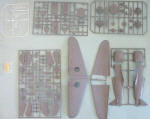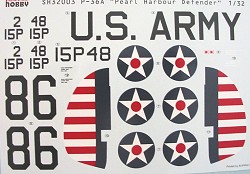
| KIT: | Special Hobby 1/32 P-36A 'Pearl Harbor Defender' |
| KIT #: | ? |
| PRICE: | $45.00 MSRP |
| DECALS: | Two options |
| REVIEWER: | Tom Cleaver |
| NOTES: | Short run with resin bits and injected clear parts |

| HISTORY |
Don Berliner, Chief Designer of Curtiss-Wright, first set pencil to paper to create the Hawk 75 in 1934, the same year that saw the birth of the revolutionary Messerschmitt Bf-109, Hawker Hurricane and the Supermarine Spitfire. The design was as revolutionary for Curtiss - at the time the premier supplier of fighter aircraft to the U.S. Army Air Corps and the U.S. Navy - as were the other designs for their respective creators. It was the first all-metal, retractable-gear, enclosed-cockpit fighter produced by Curtiss. While the XP-36 lost the 1937 Fighter Competition to the Seversky P-35, the P-36 came back the next year - powered by a better engine - to obtain the largest production order from the Army for a fighter since the First World War, and went on to spawn the P-40.
While the P-36 in its foreign derivatives saw combat in the Battle of France, in North Africa, on the Finnish-Russian front and in Southeast Asia, the only time the original P-36 saw combat with the USAAF was on December 7, 1941, during the Japanese surprise attack on Pearl Harbor. The 15th Pursuit Group was still equipped with P-36s, and two pilots of the group scored the only P-36 victories of the war - 2nd Lt. Phil Rasmussen scoring one in a P-36A, while 2nd Lt. Harry Brown shot down two attackers while flying a P-36C.
| THE KIT |
 This kit by Special Hobby effectively cancels the only other 1/32 P-36/Hawk
75 models - the Cutting Edge conversions that use the Trumpeter P-40B.
With a price comparable to the Trumpeter kit, this kit will make up into a
far more accurate P-36/Hawk 75 than can be accomplished with the
conversions I did.
This kit by Special Hobby effectively cancels the only other 1/32 P-36/Hawk
75 models - the Cutting Edge conversions that use the Trumpeter P-40B.
With a price comparable to the Trumpeter kit, this kit will make up into a
far more accurate P-36/Hawk 75 than can be accomplished with the
conversions I did.
The kit does not have the godawful Trumpeter rivets, or the overdone fabric effect on the control surfaces. The cockpit is the correct depth (which neither Trumpeter nor Cutting Edge got right). Important only to those who look at the model in plan view, it is the correct width in the rear fuselage, rather than the “gaunt” look of the too-thin Trumpeter kit. Given the breakdown of the fuselage, with a separate forward fuselage/cowling section, it is obvious that the Cyclone-powered version will be released.
While this kit is listed as a P-36A - which did not have wing guns - the kit comes with four machine gun barrels, the openings in the wing and the scribed detail for the gun bay covers, to do the 6-gun Hawk 75A-3 (another version that will obviously be released soon). A modeler will need to fill in the holes on the wing leading edge and fill in the scribed panel detail for the gun bays to create a P-36A. The good news here is that it will also be possible to do the P-36C - which had a singe gun in each wing - and this is important because the decal sheet includes the markings for Harry Winston’s P-36C (which was not a P-36A as the kit instructions would have you believe).
 The decals are
good, and allow you to make a model of the planes flown by the two pilots
who scored on December 7 - Rasmussen’s P-36A still in pre-war polished
natural metal and Winston’s P-36C in Olive Drab and Neutral Grey.
Fortunately, Cutting Edge created three very nice decal sheets for their
Hawk 75 conversions, so you can do several pre-war P-36A’s, a P-36C in the
special war games camouflage from 1938, or several Hawk 75A-3s for those
who can’t wait for the next release.
The decals are
good, and allow you to make a model of the planes flown by the two pilots
who scored on December 7 - Rasmussen’s P-36A still in pre-war polished
natural metal and Winston’s P-36C in Olive Drab and Neutral Grey.
Fortunately, Cutting Edge created three very nice decal sheets for their
Hawk 75 conversions, so you can do several pre-war P-36A’s, a P-36C in the
special war games camouflage from 1938, or several Hawk 75A-3s for those
who can’t wait for the next release.
As an aside, for those adventurous enough, this kit would provide a good basis for a “kitbash” combining this kit and the Trumpeter P-40B, with the ultimate result being far, far better than the godawful Trumpeter collection of plastic. Basically, what would be needed is the Trumpeter kit forward of the cockpit, and the center of the lower wing for the large fairing. Some cutting away, some sawing, some application of putty, some filling areas with Mr. Surfacer, some use of sanding sticks and - voila! - a moistly-accurate looking P-40B. If you were of a mind, you could take the horizontal stabs and elevators from a Revell P-40E, and have the whole thing done right.
One thing has to be done for the model: it comes with open wheel wells, which is incorrect. The P-36A/C/Hawk 75 almost always (and certainly always in pre-war units) had the canvas “boots” in the wheel wells. This can be easily created using aluminum foil pushed down into the opening, then trimmed around the edges.
| CONCLUSIONS |
Looking at the kit and comparing it with the extensive series of photos I took of the restored Hawk 75A-1 when it was at Chino last year, this model is accurate in shape and outline. The real thing has raised rivets overall, with only the leading edge of the wing back to the main spar being flush riveted. Those who obsess over such things could engrave rivet detail with a pounce wheel, but for the rest of us, the rivets can’t be seen on the real thing if you’re more than six feet away, so for the scale of the model - where most of us will be a “scale six feet” or further away when looking at it - this isn’t really an issue in need of a fix.
Steve Hinton, who is the only contemporary pilot to have flown the Hawk 75, P-40B, P-40E and P-40N, says that the Hawk 75 has the best handling characteristics of any of the P-36/P-40 series, with finger-light controls and excellent maneuverability. Kyosti Karhila, who shot down 14 enemy aircraft while flying a Hawk 75A-3 for two years on the Eastern Front, said that “the only problem was it wasn’t fast enough.”
This kit by Special Hobby will allow a modeler to make a very good model of this important yet often-overlooked airplane. Out of the box, it looks like it will make a very nice model, particularly if one were to do a pre-war airplane using Alclad II “Polished Aluminum” and use the Cutting Edge decals. Super-detailers could have a very good time with it.
Thanks to David Hannant at www.hannants.co.uk for the review sample.
November 2005
Editor's Note: If some of you are having a bit of deja vu, it is because Special Hobby used identical box art and markings in their 1/72 kit.
If you would like your product reviewed fairly and quickly by a site that has around 300,000 visitors a month, please contact me or see other details in the Note to Contributors.